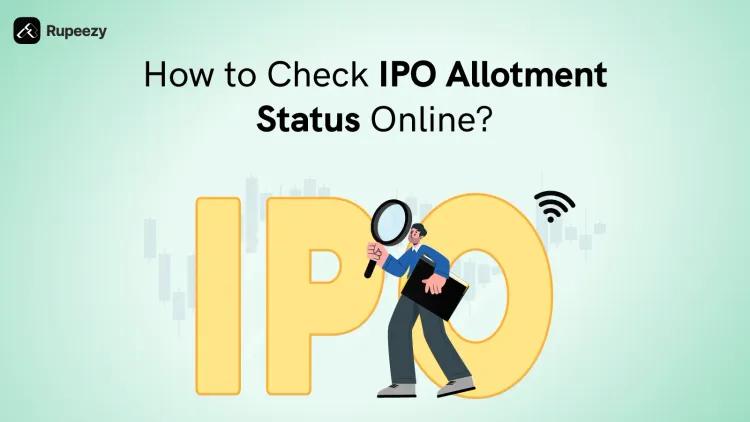How to Apply for an IPO Online – Step-by-Step Process


00:00 / 00:00
Investing in an IPO (Initial Public Offering) is a great way to enter the stock market. It allows you to buy shares of a company that is just launching. In fact, if you are already investing in shares, an IPO is an opportunity to expand your portfolio. This is a perfect way to start an investing journey, which offers growth with comparative safety.
But the question is, how to apply for IPO? To begin with, there are a few requirements: you need a Demat account, a trading account, a bank account, and your KYC details must be verified. After this, you’ll need to follow the steps outlined in this article. So, let’s dive in!
Requirements for Investing in an IPO
Now that you are planning to apply for IPO, let us check what things you need to have. This is indeed your starting point for the answer to “how to invest in IPO”. To ensure a seamless IPO application process, you need the following essentials:
1. Demat Account
A Demat account is mandatory to hold shares in electronic form. When you apply for an IPO, any allotted shares are credited directly to this account. You can open a Demat account with a registered depository participant such as a bank, broker, or financial institution by submitting your PAN card and address proof.
2. Trading Account
While the Demat account holds your shares, a trading account is necessary to buy or sell shares on the stock exchange after listing. Most brokers offer a combined Demat and trading account for convenience. Make sure your trading account is linked to your Demat account for seamless transactions.
3. PAN Card
A valid PAN card is compulsory for all financial transactions in India, including IPO applications. It acts as your unique identification and helps prevent multiple applications under the same identity, which are rejected by regulators. Ensure your PAN details are updated and linked to your Demat and bank accounts.
4. Bank Account with ASBA or UPI Facility
Your bank account must be linked to your Demat and trading accounts and support ASBA (Applications Supported by Blocked Amount) or UPI payments. ASBA blocks the IPO application amount in your account until shares are allotted, ensuring funds are not debited prematurely. UPI enables quick payment authorization during online IPO applications.
5. KYC Compliance
Complete KYC (Know Your Customer) verification with your broker or bank before applying. This process involves submitting identity and address proofs to comply with SEBI regulations. Without KYC compliance, your IPO application will not be accepted. Most brokers assist you in completing KYC during account opening.
Once you have all these, you can start on your journey to apply for the IPO. But before you apply, it is important to check a few documentation needs.
Documents Required for IPO Application
Here are the essential documents you need to buy an IPO successfully:
Document | Purpose | Details |
PAN Card | Mandatory for identity verification and compliance | Must be linked to Demat, trading, and bank accounts. |
Demat Account | To hold shares electronically | Opened via SEBI-registered depository participant (e.g., Zerodha, ICICI). |
Trading Account | To place bids and trade post-listing | Linked to a Demat account. |
Bank Account with ASBA/UPI | For payment processing (blocked funds via ASBA or UPI mandate) | UPI ID is required for online bids. |
KYC Documents | Identity and address verification (PAN and Aadhar) | Includes Aadhaar, passport, or voter ID, suggesting the applicant is 18+ years. |
How to Apply for IPO Online in India
Investing in an IPO is a great way to buy shares of a company before they become publicly traded. To participate, you need to follow a few straightforward steps. This guide will walk you through the process, ensuring you are well-prepared to buy IPO confidently.
1. Open a Demat and Trading Account
To invest in an IPO, you have to open a demat account to hold your shares electronically and a trading account to place buy or sell orders. These accounts can be opened with any SEBI-registered broker or financial institution. Make sure your accounts are linked to your bank for smooth transactions.
2. Check the Upcoming IPO Details
Stay informed about upcoming IPOs by noting the subscription dates, price band, and lot size. This information is crucial for planning your investment and deciding how many shares you want to apply for within the allowed limits.
3. Assess the Company’s Prospectus
Before applying, read the company’s Red Herring Prospectus (RHP). This document provides important details about the company’s business model, financial health, risks, and how it plans to use the funds raised. Understanding these factors will help you make an informed investment decision.
4. Fill in the Application Details
Enter the number of lots you wish to apply for and the bid price within the specified price band, or choose the cut-off price option. Provide your UPI ID if applying online. Double-check your PAN and bank details before submitting to avoid any errors.
5. Choose the Application Method (ASBA or UPI)
You can apply for an IPO either through ASBA (Application Supported by Blocked Amount) using your bank’s net banking facility or via the UPI method through broker platforms or apps like Rupeezy. Both methods ensure your funds are securely blocked until allotment.
6. Block the Required Funds
In the ASBA process, the application amount is blocked in your bank account but not debited until shares are allotted. For UPI applications, you must approve the payment request on your UPI app within the stipulated time, usually by 5 PM on the IPO closing day.
7. Wait for the Allotment Status
Wait for the IPO subscription to close. The registrar announces the allotment status within a few days. You can check the status on the registrar’s website using your PAN, application number, or DP ID to determine if you have been allotted shares.
8. Shares Credited and Listing Day
If you receive an allotment, the shares will be credited to your Demat account. On the listing day, you can choose to hold the shares for long-term growth or sell them based on market conditions and your investment goals.
In addition to this, there is an option to apply for the IPO offline as well. So, now the question is how to apply for IPO offline? Well, that is very simple.
How to Apply for IPO Offline in India?
At times, people look for an option to invest in IPO offline. Now, this is mainly when you do not have access to the internet or lack the knowledge. But for this as well, you need a demat, trading, and PAN-linked account with internet banking. So, now once you have these, here are the steps that you would need to follow:
1. Obtain the Physical IPO Form
First, you would need to visit your bank or broker. Here, you can collect the form that is to be filled out to apply for the IPO. ASBA support is a must. Hence, you must check this and secure all details as needed.
2. Complete the Form
Once you have the form, you can start filling it out. Some of the main details that you would need to add to the same are:
Demat/Client ID (from your Demat account).
PAN number.
Add the bid information, like the lot size you need, and the rest.
Bank account details for the debit amount.
3. Submit the Form at Your Bank
Once you are done, check the form. Sign it and submit it back. If needed, please share the required documents like PAN or a cross-cheque for banking details. At the same time, check the funds in your account for the IPO amount blocking.
4. Collect the Acknowledgment Slip
The bank will provide an acknowledgment slip with a unique application number. Keep this safe for tracking your application status.
5. Track Allotment Status
After the IPO closes, check allotment results on the registrar’s website (e.g., KFintech or Link Intime) using your application number or PAN.
6. Receive Shares or Refund
If allotted, Shares are credited to your Demat account within 3–5 working days.
If rejected, Blocked funds are released back to your bank account automatically.
Key Notes:
ASBA is mandatory for offline applications.
Single application per PAN rule applies (multiple bids are rejected).
Submit the form before the IPO’s closing day (usually by 3:30 PM).
Factors to Consider Before Investing in IPO
You now know the steps to follow to apply for the IPO. Now the question is, which IPO to apply for? Well, if there are multiple options, then you must select the ones that match your needs the best. But how can you find one such IPO? Well, here are a few factors that you must consider to find the best match.
1. Company Financial Health
Analyze audited financial statements for profitability, debt levels, and cash flow trends. Look for consistent revenue growth and manageable liabilities. Companies with declining margins, rising debt, or negative cash flows may struggle post-listing, increasing risks for investors.
2. IPO Valuation Metrics
Compare key metrics like PE ratio, PB ratio, and EPS with industry peers. Overvalued IPOs (high P/E) often correct sharply post-listing. A reasonable valuation relative to fundamentals ensures better long-term stability.
3. Business Model & Market Position
Assess the company’s competitive edge (patents, market share) and scalability. Strong models in high-growth sectors (e.g., renewable energy, AI) offer better returns. Avoid companies with unclear differentiators or low entry barriers.
4. Use of IPO Proceeds
Check if funds are allocated for growth (R&D, expansion) or debt repayment. IPOs prioritizing promoter exits over business development often underperform. Transparent fund usage indicates a long-term focus.
5. Management Track Record
Evaluate promoters’ experience, past ventures, and governance history. Companies led by credible, transparent management teams are better equipped to handle challenges and deliver consistent shareholder returns.
6. Industry Trends & Competition
Favor sectors with strong tailwinds (e.g., EVs, fintech). Avoid oversaturated markets with intense competition and low profitability. Regulatory shifts (e.g., green energy policies) can boost or hinder growth.
7. Risk Factors in the Red Herring Prospectus
Scrutinize risks like customer concentration, pending litigation, or regulatory hurdles. Excessive red flags in the RHP may signal volatility or hidden liabilities, increasing post-listing risks.
8. Market Sentiment & Timing
Apply during bullish markets when IPOs typically list at premiums. Avoid sectors facing economic downturns or regulatory crackdowns. Positive sentiment drives short-term gains.
Common Mistakes to Avoid While Applying for an IPO
Applying for an IPO is just amazing. But what if you applied for the wrong one? Well, you can avoid this by keeping in mind the following common mistakes.
1. Ignoring Company Fundamentals
Many investors do not check the company details. They just go ahead and bid for the IPO. Rather, you should check the performance, revenue, and history to see the potential. If you find it positive, then only invest in the IPO.
2. Overlooking Valuation Metrics
Failing to compare valuation ratios like P/E, EPS, and industry benchmarks can result in investing in overpriced IPOs. If the valuations are quite high, you can expect corrections afterwards, which can impact your returns.
3. Relying on Grey Market Premiums (GMP)
GMP offers you the unofficial data. If you rely on this and consider this as your baseline for investment, then you might be wrong. These are often manipulated, and so you must be cautious of your analysis.
4. Blindly Chasing Brand Names
Investing in IPOs of popular brands without evaluating their financial health can backfire. Even big names like Paytm or LIC faced poor listing performance despite strong brand recall.
5. Basing Decisions on Subscription Data
A high subscription rate does not guarantee listing gains. It may even reduce your chances of allotment and lead to inflated listing expectations.
6. Neglecting Post-Listing Strategy
Many investors don’t plan what to do after getting the shares. Without a clear exit or holding strategy, panic-selling during volatility becomes common, reducing potential gains.
Conclusion
Applying for an IPO is a simple process once you understand the steps, documentation, and key factors involved. Whether you’re a new investor or someone looking to diversify your portfolio, IPOs offer a good entry into equity markets with potential growth opportunities. But like any investment, it’s important to make informed decisions. Review the company fundamentals, avoid common mistakes, and have a plan for post-listing.
FAQs
Q1. Should You Sell IPO Shares on Listing Day?
It depends on your investment goal. If you're looking for quick profits and the stock lists at a premium, selling on listing day may be beneficial. However, if the company has strong long-term potential, holding the stock could yield better returns over time. Always align your decision with your risk appetite and research.
Q2. Can I Apply for an IPO Without a Demat Account?
No. A Demat account is mandatory to receive IPO shares. Even if you apply through a bank using ASBA, the shares can only be credited to your Demat account.
Q3. How Do I Know If I Got IPO Allotment?
You can check your IPO allotment status on the registrar’s website (like Link Intime or KFintech) using your PAN, application number, or DP ID, a few days after the IPO closes.
Q4. Is UPI Mandatory for Retail IPO Applications?
UPI is not mandatory, but it is the most commonly used method for online IPO applications. You can also apply using the ASBA facility through your net banking portal.
Q5. Can I Cancel or Modify My IPO Application After Submitting?
Retail investors can usually cancel or revise their IPO applications before the IPO window closes. HNI investors, however, cannot reduce or cancel once submitted, but may increase their bid.
Q6. What Happens If I Don’t Get IPO Allotment?
If you don’t get an allotment, the blocked amount in your bank (via ASBA or UPI) is released or unblocked automatically within a few working days.
Check Out These Related Articles |
The content on this blog is for educational purposes only and should not be considered investment advice. While we strive for accuracy, some information may contain errors or delays in updates.
Mentions of stocks or investment products are solely for informational purposes and do not constitute recommendations. Investors should conduct their own research before making any decisions.
Investing in financial markets are subject to market risks, and past performance does not guarantee future results. It is advisable to consult a qualified financial professional, review official documents, and verify information independently before making investment decisions.

All Category







